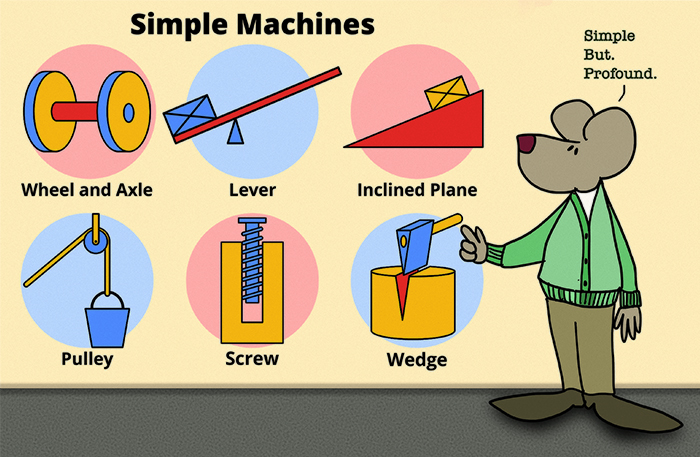I love simple machines. My dear dad taught me about simple machines when I was very young. He showed me examples. Like the crowbar. Or the wheelbarrow.
The part I am mostly thinking about is the fulcrum. I’m not sure why the word popped into my mind, but it has. A fulcrum refers to the support on which a lever moves when it is used to lift something.
But first, let’s talk about simple machines.
A simple machine is a basic mechanical device. What is its job? Well, it helps change the direction or magnitude of a force in order to perform work.
Simple machines are the grunts. They are the fundamental building blocks of more complex machinery and systems. But at the very basic level, they help us in our world. They improve our mechanical advantage.
There are six main types of simple machines:
• Lever: A rigid bar that rotates around a fixed point called a fulcrum. Levers can amplify force or change the direction of force. They include examples like seesaws, crowbars, and scissors. Seesaws are great fun. I haven’t been on one in quite some time. But just this morning, I used a scissors. As for crowbars? A sparrow walks into a bar. Seated everywhere are big black birds. The bartender says, “You’ll have to leave, little sparrow. This is a crow bar.” ( I just made that one up.)
• Wheel and Axle: A wheel connected to a smaller axle. When force is applied to the wheel, it causes the axle to turn. Examples include wheels on vehicles and doorknobs. Need those wheels for my wheels.
• Pulley: A grooved wheel with a rope or cable running through the groove. Pulleys are used to lift heavy loads with less effort. They can be simple (single pulley) or combined to create complex systems. I sure do love a good pulley. Pulleys can help lift buckets of bricks high up in the air. I’ve seen it in movies.
• Inclined Plane: A sloping surface that reduces the amount of force needed to lift an object vertically. Examples include ramps and staircases. Up and down we go. The loads on the inclined planes, we are.
• Wedge: A triangular-shaped object with a sharp edge. Wedges are used for splitting or cutting objects, and they include items like knives, axes, and chisels. I know knives. I’m good at cutting foodstuff. I’ve used axes and chisels, too. But not on foodstuffs.
• Screw: An inclined plane wrapped around a cylindrical post. Screws are used to hold things together or to lift objects by rotating the screw. Examples are screws, bolts, and jar lids. Jar lids are especially magic.
So, I had to name all the simple machines. But the thing I love the most is the fulcrum. It comes to us, most of the time, in the lever.
The fulcrum is fundamental when it comes to a good lever.
The position of the fulcrum determines the type of lever and how it functions.
Levers have different classes, also.
First, second, third.
• Seesaws, crowbars, and scissors are first-class levers. (Technical: The fulcrum is positioned between the effort and the load. In this type of lever, the effort and load move in opposite directions.)
• Wheelbarrows and nutcrackers are examples of second-class levers. (Technical: The load is located between the fulcrum and the effort. In this configuration, the load moves in the same direction as the effort, providing a mechanical advantage.)
• Tweezers and fishing rods are third-class levers. (Technical: The effort is applied between the fulcrum and the load. This type of lever typically provides a speed or distance advantage rather than a mechanical advantage.)
That fulcrum sure does a lot of work. Wherever it goes.
And maybe that’s why I like the fulcrum so much. It sees a need, and it gets the job done. It provides the main point of helping a task through to completion.
Quietly, it sees what needs to happen and acts as a pivotal point in the entire operation.
We could learn a lot from those fulcrums, I’ll tell you.
May we all have a little bit of fulcrum in us. Each and every day.
“”””””””””””””””””
The key to growth is the introduction of higher dimensions of consciousness into our awareness.
— Lao Tzu
“”””””””””””””””””
Life is a succession of lessons which must be lived to be understood. All is riddle, and the key to a riddle is another riddle.
— Ralph Waldo Emerson
“”””””””””””””””””
Make each day your masterpiece.
— John Wooden
“”””””””””””””””””
It is as simple as the thing-a-mabob in the middle.
